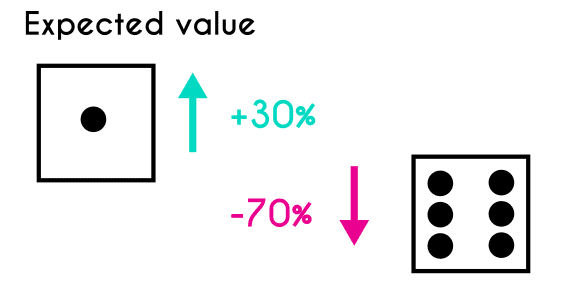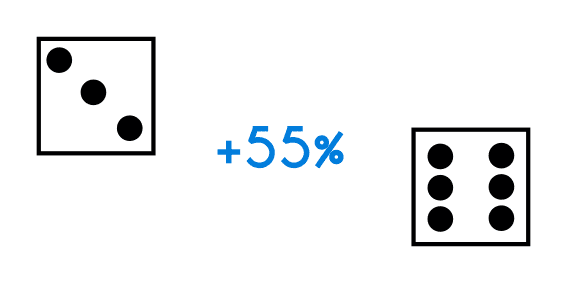Expected value - Definition and examples
This article will be about The concept of the expected value, with examples of how to find it.
The expected value is an average of the obtained results of an aleatory event. The expected value allows us to determine if the result of making an aleatory event is positive or negative, this does not means that the expected value calculates the probability of an outcome, the expected value calculates the consequence in terms of earnings and loses caused for the outcomes and their probability.
The expected value is useful in casino games, because the expected value helps to know which games are more convenient to play, and which are not, because this process does not determine the probability of winning or losing a game, instead the expected value calculates if the earnings are going to be higher than the loses, or vice versa, without taking into account how many times we lose or win.

Something that is important to clarify is that the expected value is going to have a greater efficiency if the aleatory experiment is done a great number of times, because the value we find in this method reflects what is going to happen after we have done the event a great number of times.
When we calculate the expected value, it is not always going to give us a result that is equals to an outcome, but this is normal because as we said before, the expected value does not defines which outcome is most likely to happen, it defines an average of what we are going to get. To know of a practical way the use of the expected value we are going to suppose that when we toss a coin, if it lands in heads we loose 2 dollars, but if it lands in tails we earn 1 dollar. In this example the outcomes are losing 2 dollars, and earning 1 dollars, where the probability of each outcome is going to depend on the probability of each face, in this case the expected value is going to give us the average of the earnings in each round, if we do this experiment many times.

The expected value can only be found when the probability of the outcomes are constant in each iteration, for example, when we toss a coin, the probabilities of both heads and tails is always going to be 50% (½). In case we have non constant probabilities, we cannot calculate the expected value of this.
Formula of the expected value
- Formula for the expected value
- E(x) = Σ Xi * P(x)
In the formula E(x) is the expected value of an experiment, xi is every value of every event and p(x) is the probability of the event.
Examples of the expected value
Example 1: In a game a person rolls a dice as many times as he wants and the rules of the game are: If the dice lands on the 1, 2, 3 or 4 side, then the person loses 5 dollars, but if the dice lands on the 5 or 6 dice then the persons earns 10 dollars, calculate the expected value for this game.
First we are going to represent the data in a table so we can have a better look on the game.
| X | -$5 (1,2,3,4) | $10 (5,6) |
|---|---|---|
| p(x) | 4/6 | 2/6 |
What we will take as “X” is the money that we could earn or lose, not the sides of the dice, because the event is that we either earn or lose money.
- E(x) = (-$5 * 4/6) + (10 * 2/6)
- E(x) = -3.33 + 3.33
- E(x) = 0
The expected value in this game is of $0, it means that if we play this game over and over again, it is very likely that we end up with the same amount of money we started.
Example 2: A machine throws a random number between 1 and 20, if we get a number between 1 and 7, the player loses $2, if we get a number between 8 and 18 the player earns $1 and if we get 19 or 20, the player earns $3, calculate the expected value for this game.
| X | -$2 (1-7) | $1 (8-18) | $3 (19-20) |
|---|---|---|---|
| p(x) | 7/20 | 11/20 | 2/20 |
Same as before the values of “X” will be the money we earn or lose.
- E(x) = (-$2 * 7/20) + ($1 * 11/20) + ($3 * 2/20)
- E(x) = -0.7 + 0.55 + 0.3
- E(x) = $0.15
Example 3: A businessman wants to buy a company, of which he has the profit and loss data, if he has the probability of the monthly profit and loss, how convenient is for him to buy this company.
| Earnings /months | $200 | $100 | -$30 | -$500 |
|---|---|---|---|---|
| p(x) | 3/8 | 3/8 | 1/8 | 1/8 |
- Now we find the expected value
- E(x) = ($200 * 3/8) + ($100 * 3/8) + (-$30 * 1/8) + (-$500 * 1/8)
- E(x) = 75 + 37.5 - 3.75 -62.5
- E(x) = +$46.25
In conclusion even when there is the possibility that the company losses $500 dollars a month, the most likely thing to happen is that the company will earn more than the losses.